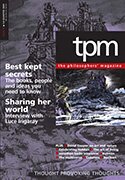
Jean Kazez
After a dry-spell of about two years, I am finally in love … with a novel. The Evolution of Bruno Littlemore, by Benjamin Hale (Twelve Books), is the autobiography of an upwardly mobile chimpanzee. Bruno recounts his life story to Gwen, an intern at the Zastrow Primate Research Center in Georgia, while reclining on a couch and sipping a glass of iced tea. A seasoned ape of 24, he’s bipedal, hairless, and loquacious. He’s an actor, an artist, and an astute observer of the human condition; and he’s more-or-less a murderer (as we learn on page one).
Bruno begins his memoirs with the earliest sign that he is atypical. “I never felt like I quite belonged to the same species as my mother or Céleste.” That’s Céleste his cage-mate at the Lincoln Park Zoo. “I loved Céleste, but I did not lust after her. I did not lust after her because she was a chimp. My erotic desires lay elsewhere, yes, even then.”
Bruno desires women – human women. Daily they “sashay in their anthropic glory” past his quarters at the Lincoln Park Zoo. Then, when he is six, primatologist Lydia Littlemore enters his life. Entranced by her long blond hair, intoxicated by her smell, and happy in her arms, off he goes to a behavioural psychology laboratory at the University of Chicago, where he stuns the scientists with his cognitive and linguistic skills.
Soon Bruno is living with Lydia, occupying the room that once belonged to her infant son, now dead. He learns to understand English, then learns to speak, and falls in love with one facet of human existence after another. He adores his new room. “My room! My, my, my, my room! Mine! My area! My space! (Do you realize what a godly luxury is the first-person possessive pronoun applied to physical space?)” He loves books and music, and he loves a TV show called Francis the Gnome; he loves the smell of women and watching them put on stockings; he loves Van Gogh (he starts painting himself) and department store manikins.
The world of humans contains so many delights, but strange and terrifying things too. Bruno overhears Lydia and friend Tal Gozani (she of the terrifying puppet collection) discussing Noam Chomsky’s view that non-human primates have no real capacity for language and starts regularly dreaming about a creepy, sinister, sallow creature – “the Gnome Chompy.” In one of his dreams, “it was as if there was cement hardening in my throat. I could not even move my hand to point. The Gnome Chompy had robbed me of all my powers of communication.” Bruno is horrified and fascinated by the way humans insist on a clear, impermeable line separating the human species and every other.
It turns out that Lydia is not just flexible about gender (Tal becomes a lover), but flexible about species. Bruno and Lydia fall deeply in love. Their love life gets off to a rough start (human bedroom rules and manners are tricky), but Bruno’s lust for Lydia is matched by Lydia’s for him. Nooooooooo! Yes. But don’t call it bestiality (Bruno explains). Bestiality is what Bruno’s father does to a frog at the beginning of the novel, with bad results for the frog. Our big reaction to inter-species sex (laugh, gasp, scream), even if both partners are essentially human, reveals a great deal about the deep importance we attach to species boundaries. (Peter Singer’s infamous essay “Heavy Petting” says more about that topic.)
Not only is Bruno outwardly an ape, but when the love affair begins, he’s still drinking from a sippy-cup and watching Sesame Street. He’s two feet shorter than Lydia. But never mind – they are in love, and the sex is abundant and fantastic, we are reminded over and over again. (What’s with Lydia? We never really find out.) Then there’s trouble (how could it be otherwise?). There’s a murder and a flight – as we know there will be on the first page – and many other adventures (perhaps a few too many).
Bruno is a lucky ape who constantly finds himself in the company of supportive, open-minded humans. But he also encounters his share of misfortune. Though a passionate humanist, and conversely, something of a speciesist – he finds his fellow apes pretty idiotic and gross – he’s also an advocate for animals. He demands his due, as an ape, and fair treatment for more strictly simian apes than he.
How can the human-animal boundary be seriously explored in the autobiography of such an unreal animal? It can, because Bruno’s journey to full humanity illuminates what full humanity comprises. And also because Bruno is a philosophical ape, given to wonderfully engaging rumination about a vast array of subjects. The most striking thing about this novel is Bruno’s charming, captivating, immensely entertaining voice. Over the novel’s nearly 600 pages, he became so real to me that I can just about imagine that he’s still at the Zastrow Research Center, rehearsing for his next theatrical performance, or working on a second set of memoirs, or seducing Gwen – but probably all three.
Jean Kazez teaches philosophy at Southern Methodist University in Dallas and is the author of Animalkind: What We Owe to Animals (Wiley-Blackwell, 2010).
 Email This Post
Email This Post 



So intriguing and so sensible. The exploration of the animal-human boundary cannot get anywhere except in and through imaginative literature. The ’scientific’ approach will get us nowhere because science, by objectifying its ’subject’ kills the subjectivity of the subject, which is what we really want to understand.
It was a much easier read than Levinas